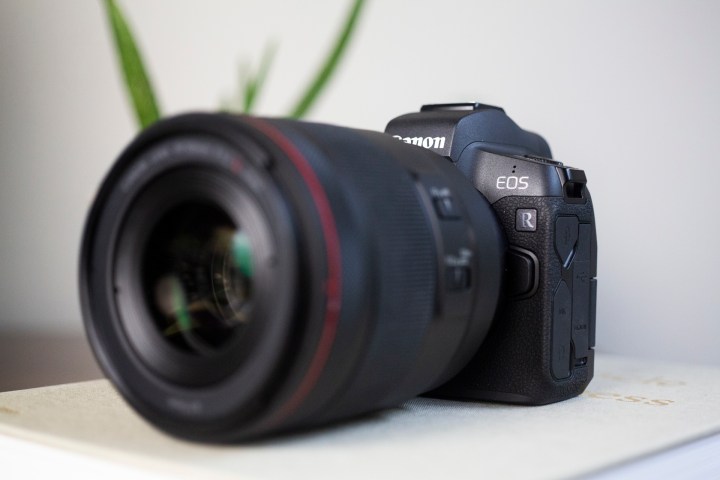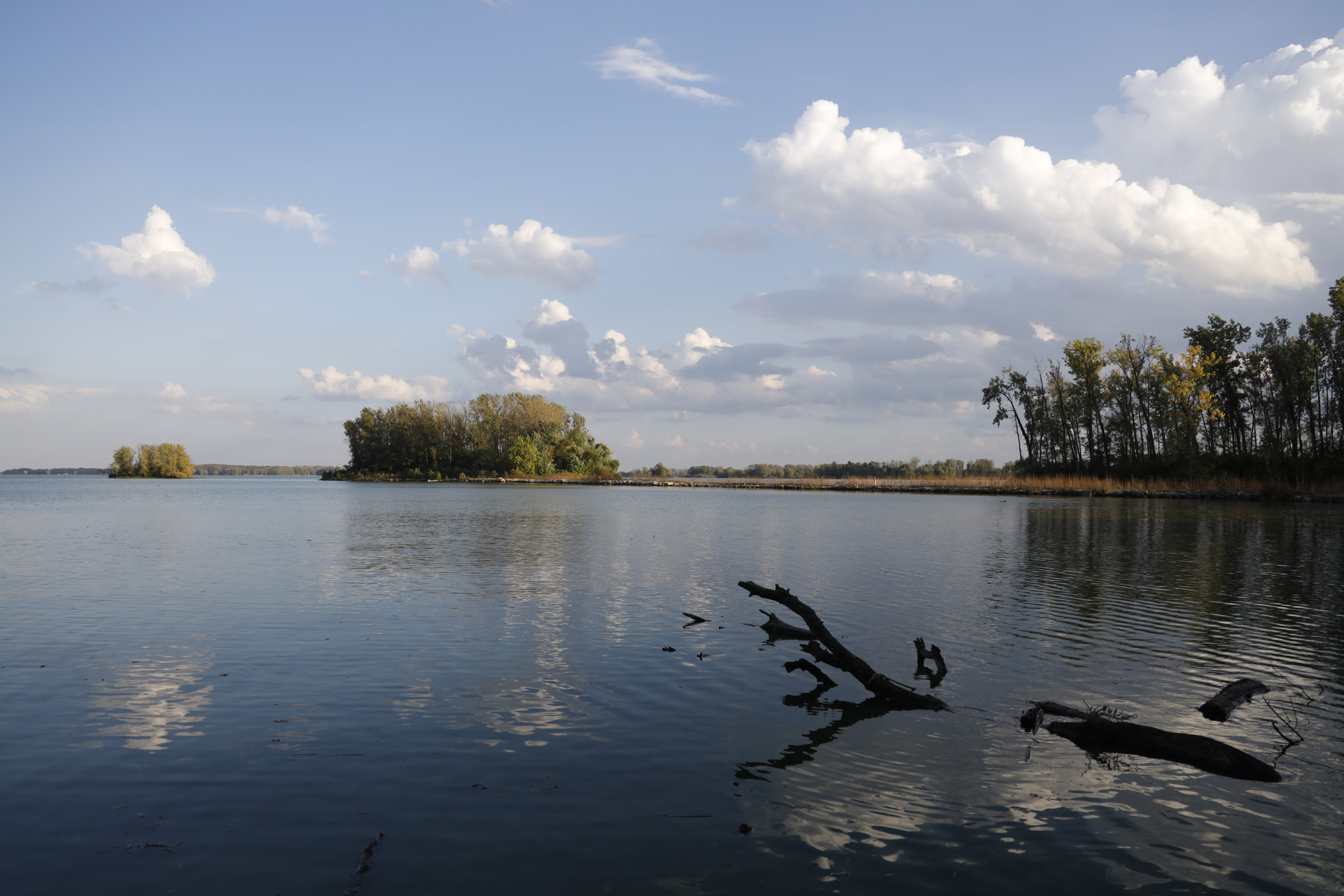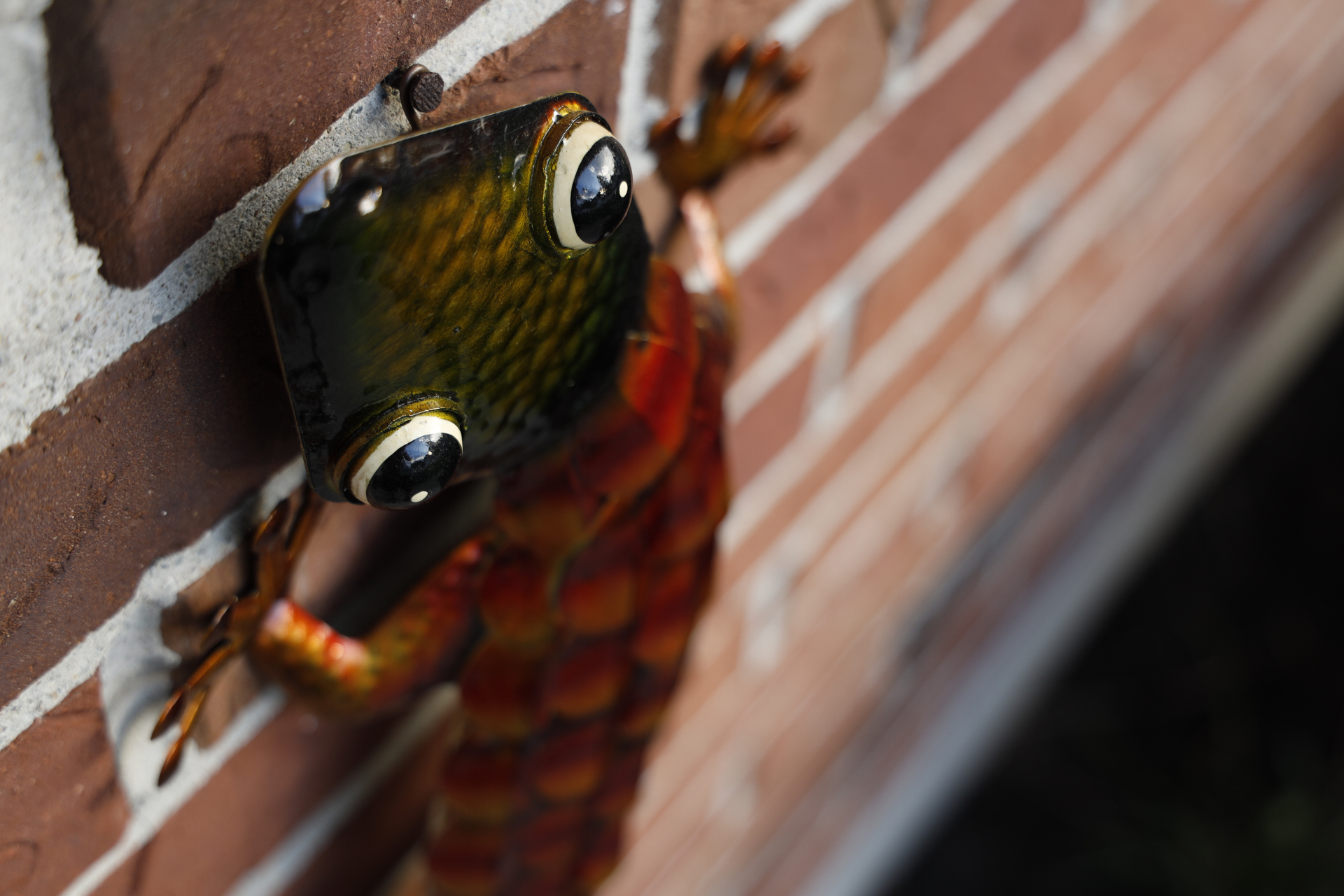- 5D Mark IV sensor in a smaller body
- Fantastic EVF
- Lots of customization
- Great autofocus
- Works with older lenses via adapters
- No in-body stabilization
- Burst rate limited to 5 fps with continuous AF
- Single SD card slot
After nearly a decade of rumors, patents, and anticipation, Canon has laid its cards on the table, showing off its first full-frame mirrorless camera — the EOS R.
When President and COO of Canon USA, Kazuto Ogawa, announced the Canon EOS R on stage at its event in early September, he shared an interesting anecdote. During development, when Canon asked itself whether the EOS R was an “evolution or a revolution,” it realized the answer was simply “yes.” Although it was likely meant to be tongue-in-cheek story, this inquiry and accompanying answer is one we kept coming back to during our hands-on time with the EOS R.
In many regards, the EOS R doesn’t feel like any sort of transition at all. It looks similar to a DSLR, its specs are similar to a DSLR, and it overall feels like a DSLR. But in so many other ways, it feels like something entirely different, something deserving of being called a revolution — especially when you consider it’s simply the first of many iterations to come in Canon’s newest mirrorless endeavors.
Specs: What’s old, what’s new
Packed within the magnesium alloy frame of the EOS R is a 30.3-megapixel full-frame sensor with Dual Pixel RAW — the same sensor found inside the EOS 5D Mark IV, one of our favorite full-frame DSLRs. It has a maximum continuous drive speed of up to eight frames per second and an expanded ISO range of 50-102,400.
On the cinema front, the EOS R actually steps things up over the 5D Mark IV. It captures 4K at 30 fps, 1080p/60, and 720p/120 video, like the 5D, but Canon also built in its C-Log gamma curve as well as 10-bit HDMI output if you’re shooting with an external recorder.
While the 5D already had Dual Pixel Autofocus (DPAF), the EOS R uses an entirely new version with 5,655 focus points. Canon’s Digic 8 image processor — the same one found in the recently-released EOS M50 — handles both the autofocus and image processing.
The Canon EOS R is an entirely new system.
On the rear of the camera is a 3.15-inch, 2.1-million-dot articulating LCD touchscreen, while a 3.69 million-dot OLED display powers the electronic viewfinder (EVF). Both are brilliant.
The EOS R also has a new customizable Multi-Function Bar located next to the EVF eyepiece, which we will explain in detail later. Images and video are saved to a single UHS-II SD card slot which, like the single XQD slot in Nikon’s competing Z7, may or may not be a dealbreaker for you. Finally, as is the norm now, both Wi-Fi and Bluetooth are offered for transferring files or controlling the camera remotely from a smartphone app.
Design, features, and usability
The Canon EOS R is an entirely new system — the first of its kind for Canon. But you wouldn’t necessarily know that at first glance. Sticking with Canon’s standard design approach, the EOS R looks like a more robust EOS M50, complete with a more pronounced battery grip.

The EOS R is a great deal smaller than the body of a 5D-series cameras (see it compared to a a 5D Mark III below). Despite this, it doesn’t feel any less substantial in the hands. The magnesium frame gives it a sturdy feel and a reassuring weight. The battery grip is smaller than that of the 5D Mark III, but it doesn’t feel too small, even in larger hands. In fact, when we tested out Canon’s new 400mm f/2.8L IS III on the body, we were able to comfortably carry it around without much problem. This might be more of a testament to the weight reduction in the 400mm, but it also highlights the ergonomics of the EOS R, even in less-than-ideal situations.
The LCD monitor, with its very high 2.1-million-dot resolution, is an absolute joy to work with. The screen is responsive and the familiar menu interface is easy to navigate, even with larger fingers. There’s even a neat little trick up its sleeve when it comes to autofocus.
The EOS R is packed with customizable functionality from front to back — and it doesn’t end with the camera.
When the EOS R was revealed, one of the most notable exclusions was an AF joystick. Having been a staple on other Canon cameras for a few years now, we dreaded the idea of using the directional pad (D-pad) as the sole means of moving the focus point around the EVF. We even started this review thinking the lack of a joystick was going to be one of the most notable flaws of the camera. But Canon was clever to copy the touch pad AF feature seen in other mirrorless cameras.
When looking through the EVF, simply slide your finger around the touchscreen to move the focus point. You can customize this feature to omit certain parts of the screen so your nose or cheek won’t accidentally change the focus point when your face is pressed up against the camera.
Of all the major camera companies, Canon has been one of the most hesitant to provide thorough user customization options. Sure, there have been a few customizable buttons and dials on past Canon cameras, but even those were neutered due to the limited settings Canon made available.
That’s no longer the case. The EOS R is packed with customizable functionality from front to back — and it doesn’t end with the camera. In addition to the vast array of programmable settings, the Multi-Function Bar (we’re getting there), and clever autofocus point management, Canon has also introduced a Control Ring for all RF lenses. The Control ring is a physical ring around the barrel of the lens that lets you adjust settings on-the-fly, such as aperture, shutter speed, ISO, and more.
OK, let’s talk about that Multi-Function Bar. This little addition is essentially a new and improved version of the touch functionality previously seen on the scrolling wheel of recent Canon DSLRs. Instead of being a wheel, it’s a little strip just to the right of the EVF. The Multi-Function Bar has three customizable controls: two arrows and a slider that connects them. The two arrows can be programed to perform a certain function when tapped.
Autofocus is the real star of the EOS R show, and it is very fast.
There are more than a dozen options to choose from, but we settled on using it for setting a particular ISO. When we pressed the left arrow, it instantly set the camera to ISO 100; when we pressed the right arrow, it immediately went to ISO 400. Likewise, we programed the sliding motion to go through the various ISO ratings, starting at 100 and ending at 32,000.
Our implementation is just one of many options you can choose from. The Multi-Function Bar can control aperture, shutter speed, exposure compensation, and much more.
Performance
The 30MP sensor may not be new, but the EOS R manages to get more from is thanks to an improved AF system and Canon’s Digic 8 image processor (for comparison, the Canon 5D Mark IV used Canon’s Digic 6+ image processor).

The more robust processor has led to an increase in capture rate in continuous mode. The EOS R can capture up to eight frames per second — a frame up from the 5D Mark IV. However, the eight frames per second is only possible with one-shot autofocus. With servo, or continuous autofocus, you’ll be limited to just five frames per second. That might not be a dealbreaker, but it’s certainly something to consider. Also, keep in mind the EOS R is not billed as a sports camera and is just the first of many R-series cameras to come.
While on the topic of shooting moving subjects, another point of emphasis is the electronic viewfinder. Not only is the 3.69 million-dot OLED display crystal clear, it also has zero-blackout shooting. When you press the shutter, the screen never goes black. It pauses briefly, holding the frame when the shutter was pressed, then automatically jumps back onto the live view.
Much like the 5D Mark IV, the EOS R has solid image quality across the board.
We didn’t use scientific means of measuring speed, but the delay in the EVF appeared to be equal to or less time than what it took the mirror on a 5D Mark III to flip up and capture an image. It’s not quite at the level of Sony’s A9, but considering the A9 costs over 2.5 times as much, it’s not much of a surprise.
Autofocus is the real star of the show, and it is very fast. On the native RF lenses we tested out (the 50mm f/1.2 and 24-105mm f/4) autofocus had no issues switching between foreground and background subjects with ease and consistently tracked moving subjects. The only time we ran into issues is when the subject was backlit and walking towards the camera — occasionally the EOS R would hunt for focus before picking back up on the subject.
Battery life is CIPA-rated for 350 shots per charge with the EVF and 370 shots per charge using the LCD. It’s usually safe to assume double the CIPA rating with normal usage, but in our experience, we were easily getting three to four times that, even in cooler conditions. The EOS R comes with an LP-E6N battery, but older Canon LP-E6 batteries work as well (they just have a slightly decreased capacity).
Image quality
Considering the EOS R gives you the same sensor as the 5D Mark IV but for nearly $800 less, we’re already a bit impressed. Much like our experience with the 5D Mark IV, the EOS R has solid image quality across the board. The sensor hits the sweet-spot in terms of resolution (6,720 x 4,480); there’s more than enough detail for even the largest of prints, but it won’t chew through memory cards while out on assignment — especially if you use Canon’s new C-RAW image format.
The tones and color rendering varies from lens to lens, but using Canon’s RF 50mm f/1.2 as the baseline, the resulting images look fantastic out of camera. For all of our sample shots, we used Canon’s “Standard” profile and shot JPEGs. As the images show, the EOS R yields clean, consistent images. The JPEGs were actually pretty easy to work with in post, but obviously RAW will give you more dynamic range.
As is to be expected, the ISO performance of the EOS R is similar to that of the 5D Mark IV. It looks solid up to around 20,000 — even 32,000 doesn’t have a terrible amount of noise. The expanded H1 (51,200) and H2 (102,400) settings got the job done, but unless you’re doing top-secret surveillance and absolutely need it, it’s probably better to stick with ISO 32,000 or lower.
Video
Although the 5D Mark II took the video world by storm, Canon has since dragged its feet when implementing new video capabilities in its DSLRs. The EOS R hasn’t done quite as much as we would have liked, but it does at least come out ahead of the 5D Mark IV.
One of the — if not the — most significant additions to the EOS R is Canon’s brand-new RF lens mount.
On the downside, the EOS R’s 4K/30 capture is greatly limited by the massive 1.7x crop factor. That’s an effective frame size that is smaller than APS-C, making it quite difficult to get a wide-angle shot without adapting one of Canon’s APS-C-specific EF-S lenses to the camera. The articulating LCD display would be great for composing blog-style videos, but, again, it’s all but impossible to do so without investing in an adapter and a wide-angle EF-S lens.
The new 24-105mm lens is more than wide enough for selfie-style stills, but when shooting with it in video mode, it effectively becomes a 40mm lens, which is no bueno for vlogging, even if you’re holding the camera extremely far out.
But the 10-bit output and included C-Log do give the EOS R an edge over other Canons, and offer some hope that Canon will add even more robust video features into future EOS R cameras. Sony has a huge lead in full-frame mirrorless and it hasn’t been shy about throwing as many pro video features into its cameras as it can muster; we’ve already seen Nikon try to do the same, and Canon will now have to follow suit if it wants to keep up.
That said, if you’re not interested in vlogging or actually prefer the crop factor for a little extra reach from your lenses, shooting video on the EOS R is a (mostly) solid experience. The Dual Pixel autofocus system works great across both RF and adapted EF lenses and the touchscreen makes it simple to pick your target and stick with it, even as it moves throughout the scene. Focus peaking also makes it easy to use manual focus if you still don’t trust DPAF or just want more control.
However, there is a downside. The electronic shutter exhibits such a strong rolling shutter effect that it’s nearly impossible to use the camera handheld without a stabilized lens. If you shoot a lot of video and plan on picking up this camera, we highly recommend investing in a good tripod, monopod, or gimbal — and try not to pan too quickly. It would have been nice to see Canon make an improvement here over the 5D Mark IV, but it hasn’t.
Lenses and adapters
One of the — if not the — most significant components of the EOS R is Canon’s brand-new RF lens mount. Designed from the ground up, this 54mm diameter lens mount is the heart and sole of not only the EOS R, and is the foundation of Canon’s mirrorless future. The RF mount isn’t just about accommodating the shorter flange back distance of mirrorless. It also features a 12-pin electronic contact system, compared to the 8-pin system used on Canon EF and EF-S mount cameras. This allows for more robust image stabilization and autofocus capabilities with current and future RF lenses.
It is incredible how well DSLR lenses work with Canon’s EF and EF-S mount to RF mount adapters.
The 20mm flange-back distance (the distance between where the lens attaches to the camera and where the sensor is) isn’t as short as the Nikon Z-mount’s 16mm, but it still opens up some creative potential. It lets Canon — and third party lens manufacturers — get far more creative with their respective lens designs by getting the rear optical element of the lens closer to the imaging sensor.
This is seen in Canon’s new RF 35mm F1.8 Macro, which has a nearly identical optical design as the EF 35mm F1.4, but manages to add macro capabilities and 5-stop image stabilization, all while reducing the aperture by only a third of a stop.
We tested the EOS R with a variety of lenses, including native RF lenses, Canon EF mount lenses, and even a few fully manual lenses with adapters. One of the things that most stood out to us is how natural it feels to use any lens with the EOS R.
As is to be expected, the new RF lenses we tested with the camera — specifically the RF 50mm f/1.2 and the 24-105mm f/4 — worked flawlessly. They focused quick, rendered colors beautifully, and overall performed as to be expected from a first-party lens.
More striking is just how well DSLR lenses work with Canon’s EF and EF-S mount to RF mount adapters. We tested out Canon’s 16-35mm f/2.8L II and the new, pre-production 400mm f/2.8L IS III using the Control Ring adapter and it felt as though we were using a native lens. We had a Canon 5D Mark III on hand for comparison, and on both lenses, the autofocus was at least on as good on the EOS R as it was on the 5D — if not better.
Canon has released a collection of adapters to ensure your old Canon EF and EF-S lenses will be fully compatible.
We also had a few older manual lenses sitting around and decided to test them, which get a nice boost by the EOS R’s new features. What really makes them come to life is Canon’s focus peaking. Rather than having to line up two overlaid images or simply guess, the EOS R can overlay a red, yellow, or blue pattern around the part of the image that’s in focus. It’s not the same as using autofocus, but it certainly breathes new life into older lenses — especially since you can use it either on the LCD screen or in the EVF.
The focus peaking could use a bit of an adjustment, as even on its highest setting it can be difficult to see, but that’s a relatively simple fix that could be possible be addressed in a future firmware update.
Adapters
One of the biggest concerns with switching to a new lens mount is whether or not old lenses will work with the new systems.
While Canon’s EF and EF-S mount lenses won’t directly mount to the EOS R, Canon has released a collection of adapters to ensure your old Canon lenses will be fully compatible. Specifically, Canon has released four new adapters: Canon Mount Adapter, Canon Control Ring Mount Adapter, and a Canon Drop-In Filter Mount Adapter (which comes in ND and circular polarizer varieties).

The Canon Mount Adapter is your standard, run-of-the-mill adapter. It secures EF and EF-S mount lenses to the EOS R.
The Canon Control Ring Mount Adapter is identical to the standard adapter, except it has one of Canon’s new customizable control rings wrapped around it, adding the extra functionality found in RF lenses to adapted EF lenses.
The Canon Drop-In Filter Mount Adapters, as the names suggests, have built-in filters that make it possible to add ND and circular polarizer filters to any EF or EF-S lens, even those that weren’t able to do so before due to a protruding front element, such as Canon’s 8-15mm F/2.8 fisheye. Canon has created a clever geared mechanism that lets you control the strength and direction of the variable ND and circular polarizer filters inside — a small detail that goes to show just how well thought out these adapters are.
Each of the adapters are dust- and water-resistant and maintain autofocus and image stabilization capabilities. The adapters will also pass through any EXIF data the lens provides.
Warranty information
Canon EOS R cameras purchased through Canon or its authorized retailers, such as B&H and Adorama, come with a one-year limited warranty. Canon offers extended warranties, as well as a phone support system for general troubleshooting.
Our Take
All in all, the Canon EOS R is one of the most thorough first-generation cameras we’ve ever used.
If you’re coming from the world of DSLRs, there will absolutely be a learning curve, but if you have a little patience and are willing to approach your workflow slightly differently, the experience will pay dividends. If you’re coming from the world of mirrorless cameras, there won’t be as many changes, but still a few that’ll take time to get familiar with.
On the spec sheet, the EOS R doesn’t look like much. But it’s not the technical details that makes the EOS R a treat to shoot with. It’s the entire experience of using the system. Canon’s RF lenses are tack sharp, the adapters make older lenses feel like they were made for the new mount, the customization means you can design exactly the camera that fits your workflow, and it’s overall a pleasure to use from the time you pick it up to the time you’re taking out the memory card to offload the photos.
Is it perfect? Not by any stretch of the imagination. It lacks in-body image stabilization, the 1.7x video crop greatly diminishes its value as a cinema camera, and overall there are a few details that could be polished up. Canon has been known to play it conservative with new cameras and technology and the EOS R is no exception. But what it trades off in bleeding edge features and more robust video functionality, it makes up for in a smooth, familiar experience that feels more like a second or third generation product.
Are there better alternatives?
It seems every manufacturer has released a major mirrorless camera this year. Nikon unveiled its Z6 and Z7 cameras, Sony launched the A7 III, and Fujifilm announced the X-T3 (which uses the smaller APS-C format). All of these cameras are suitable alternatives, but it ultimately comes down to what you need from a camera and what company you’re already invested in, if any at all. The EOS R obviously makes more sense for current Canon DSLR users, but it’s also offering some unique lenses and a powerful autofocus system that could make it appeal to users of other brands.
How long will it last?
Canon is generally fairly conservative with its update timeline. Being the EOS R is a first-generation product, it’s difficult to judge how long it will survive, but the construction is solid, it’s entirely weather sealed, the specs are more than adequate for most situations, and it has the new RF lens mount, which is where Canon will presumably pour most of its future research and development into.
Should you buy it?
If you’re a Canon user who’s been looking to hop onto the mirrorless bandwagon, absolutely. It not only works with all of your EF and EF-S lenses, it actually breathes new life into them with improved autofocus capabilities and unique features introduced by the adapters. It will also feel familiar, both physically and in the software user interface. It’s just enough change to push Canon into the next generation of cameras without alienating its longtime fans.
However, if you’re a first-time camera owner looking for a mirrorless camera, it might be worth it to look around before settling on the EOS R. Yes, it’s a great camera for stills with reasonable specs, but there are far better cameras out there for video or more niche use cases.




























